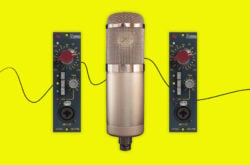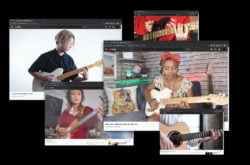Illustration: Daniel Zender
Country music is changing.
So is the instrument that plays a key role in solidifying its entire sound—the pedal steel guitar.
Their marriage is still intact; however, it’s now an open one. An increasingly diverse group of musicians have taken interest in the oblong, floor-mounted electrified guitar fretted with a steel bar, putting the instrument in the ears of many indie, ambient, and experimental fans for the first time. Pioneered by Buddy Emmons and Jimmy Day, the quintessential honky-tonk sound of the ’60s and ‘70s has by no means been erased. Rather, it’s been deconstructed and put back together by forward-thinking artists.
A highly vocal and emotive instrument, the pedal steel comes with a steep learning curve. Even seasoned lap and six-string guitarists struggle to navigate the added complexity of foot pedals and knee levers in conjunction to sliding and picking. Despite this, the midlife renaissance of the steel-guitar could be a determining factor in its continued lineage and reframing in music history.
For this piece, we invited five modern players for a roundtable discussion about their history, approach, and relationship with the pedal steel.
The steelists:
Zena Kay is a multi-instrumentalist based in Los Angeles, CA, originally from central New Jersey. Past credits include appearances with Noelle Tannen, Adult Mom, Karl Blau, Sinbad, Cosmic Guilt, Zozo Afrobeat, Rentboy, Curtis Cooper, Jack Zaferes, and many more.
Nicole Lawrence is a professional guitarist and pedal steel player residing in Los Angeles, CA. She’s currently touring with Devendra Banhart and has performed and recorded with Jenny Lewis, Mary Timony, King Tuff, Angel Olsen, Sharon Van Etten, Neil Micheal Hagerty, and Kurt Vile.
Rhodri Brooks is a photographer and musician from Cardiff, Wales. His playing can be heard on albums from Gia Margaret, Melin Melyn, Teddy Hunter, Novo Amor, Smudges, and AhGeeBe.
Barry Walker Jr. is a family man, teacher, geologist, and multi-instrumentalist from Portland, OR. He’s ⅓ of the group Mouth Painter and contributes pedal steel to albums from North Americans, Rose City Band, and Jeffrey Silverstein.
Chuck Johnson is a composer and musician residing in Oakland, CA. Recordings of his work have been published by VDSQ, Thrill Jockey, Temporary Residence, Kompakt, Ghostly, Trouble in Mind, Scissor Tail, Merge, and Three Lobed, among others.
Getting acquainted with the pedal steel
All of the musicians we spoke with were introduced to the pedal steel early in life. From being exposed to Nashville’s bluegrass scene as a child to listening to Skunk Baxter in middle and high school, from being introduced to country’s greats like Waylon Jennings and Willie Nelson by their parents to watching the Johnny Carson show, and even through listening to Sweetheart of the Rodeo by The Byrds.
Below, they tell us what drew them to the instrument and their first experiences with it.
A harmony unlike any other
If you know the sound of the pedal steel, you recognize it within the first note played. If you’re not familiar with it, it’s impossible to not become swept away by the river of sound. “It’s such a distinct sound, so emotive and vocal, but doing things a human voice could never do,” Nicole Lawrence says. “There’s so much of the player that comes through. The tone of the pedal steel guitar, the impossibility of it—it’s a stunning sound. I’m still stunned by it.”
She continues, “I’ve played electric six-string guitar for about 30 years, and currently I feel more freedom on the pedal steel guitar. It’s more exciting to me at the moment. I’m always discovering new moves and new voicings. The layout of the instrument is incredibly logical once you learn it. At first, it seems so unintuitive but once it’s all right in front of you, there are so many options of inversions, voicings, and moving things around. The span of the thing is way wider than a traditional six-string guitar. You can draw the sustain out forever if you want. I’m looking for a sense of freedom and expansiveness. I’m finding more of that on steel at the moment.”
Chuck Johnson expands on the instrument’s various capabilities. “The pedals and levers allow you to do contrapuntal things like simultaneously shifting voices within a chord up and down in pitch. I don’t know of any other analog musical instrument that can do that. Sonically, it can resemble lap steel but it’s so much more versatile. You can play several different chords and do lots of pitch bending without moving the bar on the strings at all.”
Rhodri Brooks adds, “It’s like the instrument is singing, and then also harmonizing with itself. It can sing a solo, a duet, or even a whole choir, and with such emotion. You can hear such sadness, especially with the older stuff. We sang a lot of hymns in school and I was in the choir. I love hearing those kinds of old harmonies, and pedal steel seems to live in that context a lot.”
Learning to play the pedal steel
The pedal steel is a notoriously difficult instrument to learn to play. Lawrence explains, “The learning curve is the steepest thing I’ve ever attempted by far. It took me a couple of years to get anything to sound good at all. I actually can’t believe I sat there for the first couple of years, making the same motions over and over again and tuning my body to the instrument.”
Chuck Johnson further illustrates the challenges in picking up the instrument for the first time. “I first tried one out at a music store in Durham, NC, and was so utterly confused and frustrated by it that I didn’t try again for many years. I approached it having played fingerstyle guitar and lap steel for some time. The tuning and the string spacing are so different than any lap steel I had played and I had no idea what the pedals and knee levers were supposed to do. No one at the store staffed by guitar players could offer any guidance! It’s a guitar in name only. I can’t remember if it was William Tyler or Paul Neuhaus who referred to pedal steel as ‘a complicated, sideways guitar’ but that description is spot-on.”
Zena Kay learned some tricks, drawing from past training. “It’s an unnatural feeling. Coming from a classical guitar background gave me some advantages going in. I had a good understanding of how to train right-hand technique once I learned to pick block. The right hand and bar technique is really what determines how far you can take the instrument, ultimately,” they said.
Kay continues, “One really important factor of pedal steel is the volume pedal. Tons of guitar players use volume pedals, but the approach for pedal steel is a bit more unique. Good volume pedal technique involves having your maximum volume only partially up the travel of the volume pot, and using the rest of the travel for sustain. You kind of get the best of every world. I believe that for the most part, pedal steel can even emulate what a lot of piano players do. Anything can be communicated, really.”
Barry Walker also had insights into the learning process as a beginner. “When playing pedal steel, there are a handful of fundamentals that are important: the picking, the operation of the pedals / levers, and the bar (slide) placement. It initially seems easy to play! You can mash those A+B pedals forever at different positions and it sounds so sweet to the ears. But then try to record yourself and you’ll discover you’re playing slightly out of tune, most of the time. The positioning of the bar is probably the greatest obstacle to playing good pedal steel, especially for beginners (the ‘slide’ we use is called a ‘bar,’ as it’s usually a metal cylindrical bar tapered to a round end).”
The mind-body connection of the pedal steel
The pedal steel guitar is a very physical instrument. A player must feel connected to it, both emotionally and physically—and for some, even spiritually. Technique is crucial for establishing your unique sound and every player is different.
Lawrence shares, “Playing the instrument and working at it continually has fundamentally changed the way I relate to my entire body. I tune the guitar but then I think about tuning myself, coming into alignment with it. It requires your entire body, your intonation, tone, and feel to be in one-to-one alignment with your physiology. If my movement is impeded then my sound is impeded. All music is movement practice, but pedal steel particularly so. If I’m agitated, you’ll hear it. If I’m really grounded and centered, you’ll hear that too.
Brooks adds, “It can be like some sort of weird interpretative dance—both legs going wonky, up and down, your left arm flailing side to side, and your head bobbing up and down and leaning forwards and backward. There is a definite mind / body connection when playing. You can really lose yourself.”
Johnson describes the coordination the pedal steel demands. “I never learned how to play drums or church organ, so the pedal steel is the only instrument I play that involves all four limbs. It’s a very unique kind of muscle memory that forms when you learn how to play it. For example, doing something expressive with your hands is required for most instruments, but moving a metal lever with your knee in a way that feels musical takes a lot of practice.”
Breaking gender and genre boundaries
Historically, the pedal steel has been associated with country music. Today, we’re seeing it take up space across many genres, but that’s not an entirely new phenomenon.
Johnson reflects, “Daniel Lanois broke new ground in his collaborations with Brian Eno, and around the same time, Chas Smith played on Harold Budd recordings, and B.J. Cole played with artists like David Sylvian and John Cale. It’s interesting that these crossover moments happened during the time that the instrument was in a major slump across country and mainstream pop music—in the 1980s. Today, Susan Alcorn and Heather Leigh are playing the pedal steel in completely new contexts for the instrument in improvised and experimental music. A lot of people are hearing the instrument for the first time thanks to Robert Randolph and other popular players from the ‘sacred steel’ school of gospel music.”
Kay adds, “The main thing that’s responsible for its continued existence is the people who are picking it up, learning, and convincing others to do the same. There are people playing now who are doing things that have never been done on the instrument before. That’s a sign that it will continue to grow. I’m convinced it will never die, and I’m only seeing more people learning and teaching what they know.”
Like so many cultures within the music industry, pedal steel culture skews heavily toward male / male-identifying artists. We asked these musicians what their experience has been as they’ve interacted with other players.
Johnson shares, “Unfortunately, this can be said about a lot of instruments and entire genres of music. The world of pedal steel players is relatively small and insular. From what I’ve seen, the players who seem to be the most active in the online community are older men. The tradition and knowledge of the instrument was mostly carried through that pre-internet period by people playing in country bands in local bars. Now the instrument is at a crossroads, as many of the people who developed the techniques and honed the mechanical designs that are being used today are passing away, and players often have to learn to play, repair, and maintain complicated instruments on their own. Keeping the instrument alive depends on people sharing knowledge as well as people being willing to learn, so bringing new folks into the fold with a multitude of backgrounds is absolutely essential.
Walker adds, “Hopefully this does change. We need to amplify the sounds of non-male musicians, non-binary musicians, and BIPOC musicians. An easy place to start is with your gigs. Let’s make our bills more diverse!”
The growing interest in pedal steel across genres
As pioneers in the space continue to demonstrate the versatility and nearly endless sonic possibilities of the pedal steel guitar, demand is growing for its haunting harmonies from different corners of the world and types of music. Johnson tells us, “I’m seeing more requests for the instrument, which is an encouraging sign for the future! I frequently get emails or social media messages from younger musicians asking about pedal steel.”
Kay shares, “I spend a good amount of my time overdubbing pedal steel remotely on songs from all kinds of artists. It’s one of my favorite things to do at the moment. There’s so much potential for pedal steel to play a part in modern music styles in ways many people don’t consider. String sections, horn sections, synth sounds, effects, or just classic steel sounds can all be possible or contributed to!”
Lawrence tells us, “I recently played some steel on a new song for Kurt Vile, and I’m working on a track for Mary Timony right now. The Jenny Lewis shows I was on were opening for Harry Styles, so those were arena shows. It was a real hoot to play steel on a gig like that.”
With all of this growing interest in the sounds of the pedal steel has come a burgeoning community of people who don’t fit the stereotype of the old white man the instrument is associated with. The players mentioned above have been excited to see so much conversation happening on the internet and in real life.
Bonus: Gear and influences
Thinking about giving the pedal steel a try? Here’s the players and go-to gear that influence the musicians who contributed to this article.
Kay:
- Guitars: Williams S10, MSA Legend D10
- Amp: Quilter 202 head with a 15” quilter cab
- Pedals: EarthQuaker Devices Avalanche Run, Strymon Flint, Eventide H9, Telonics FP-100 volume pedal
- Influences: Buddy Emmons, Lloyd Green, Tom Brumley
Lawrence:
- Guitars: Sho-Bud Pro 1.
- Amp: Sho-Bud Christmas Tree amp, ’55 Fender 5E3 Tweed Deluxe, Milkman 100-watt head
- Pedals: Mu-Tron Phasor (or an Echoplex in the studio), Hilton volume pedal
- Influences: Ralph Mooney, Ben Keith
Brooks:
- Guitars: GFI Ultra (three pedals, four knee levers)
- Amp: Fender Blues Jr.
- Pedals: Electro-Harmonix Holy Grail Reverb, BOSS DD-7 Delay, TC Electronics Tremolo
- Major influences: Ben Keith, Lloyd Green, Leo LeBlanc, Pete Drake
Walker:
- Guitars: Sho-Bud pedal steel guitars: Pro-1, D-10 (double neck, both with 10 strings), S-10 (single neck with 10 strings)
- Amp: Peavey Nashville 400
- Pedals: digital delay, analog delay, custom overdrive pedal (built by Josh Holmes), Archer Ikon, Moogerfooger Ring Modulator.
- Major influences: Paul Franklin, Buddy Emmons.
Johnson:
- Pedals: Eventide H9 for delay and reverb, iPad / laptop for granular delay, modulation, or additional reverbs
- Pre-amp pedal: Ethos Clean II
- Major influences: Jerry Garcia, Susan Alcorn, Tom Brumley, Barbara Mandrell, Lloyd Green, BJ Cole, Daniel Lanois
Do you play the pedal steel guitar? What instrument would you like to see us highlight next? Let us know in the comments below.
Explore royalty-free sounds from leading artists, producers, and sound designers:
November 17, 2021



